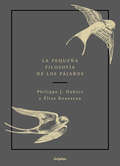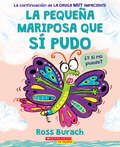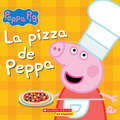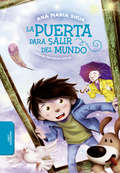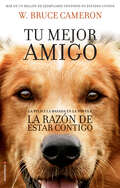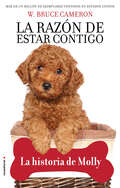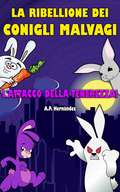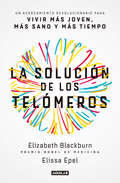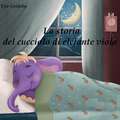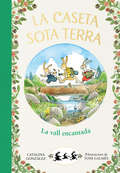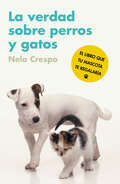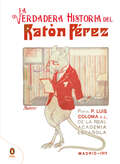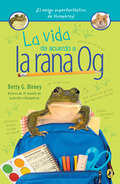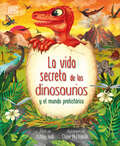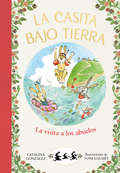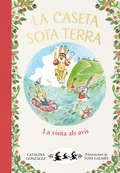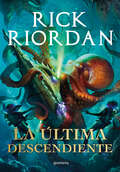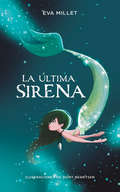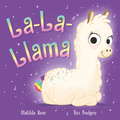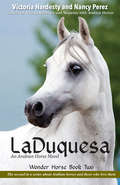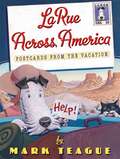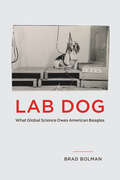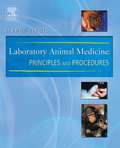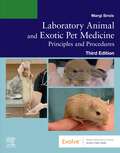- Table View
- List View
La pequeña filosofía de los pájaros
by Élise Rousseau Philippe J. Dubois22 lecciones de serenidad inspiradas en los pájaros. A menudo aprendemos de aquello que menos esperamos. Precisamente, este es el secreto que nos confía este libro. En un momento como el actual, en el que vivimos continuamente conectados al reloj o a una pantalla, estas 22 lecciones breves e inspiradoras nos enseñan a observar lo que nos rodea, pero también a reconectar con la naturaleza que sigue allí, esperándonos. ¿Y qué mejor que detener por un instante el ritmo infernal de nuestras vidas para captar lo que nos dicen los pájaros? Observando cómo estos pequeños (aunque grandes) maestros viven y están en el mundo, nosotros podemos enfocar la vida de otra manera para detenernos y reencontrarnos con nuestra verdadera esencia. Nunca es tarde, solo hace falta escuchar.
La pequeña mariposa que sí pudo (The Little Butterfly that Could)
by Ross BurachWhat if I can't?¿En qué dirección están las flores? Por ahí, a 320 kilómetros. ¡¿Cómo voy a llegar tan lejos?! Vasovolando. ¿Puedo ire n avión? No. ¡Entonces no llegaré nunca! Esta simpática continuación de La oruga muy impaciente , de Ross Burach, es un cariñoso homenaje al esfuerzo de cada niño de perseverar ante los desafíos a la vez que una alegre lección sobre la migración de las mariposas. Recuerda: si no lo logras al primer intento, ¡vuela, vuela otra vez! Which way to the flowers?That way. 200 miles.How am I supposed to travel that far?!You fly.Can I take a plane?No. Then I'll never make it!This comical companion to Ross Burach's The Very Impatient Caterpillar pays loving homage to every child's struggle to persist through challenges while also delivering a lighthearted lesson on butterfly migration. Remember, if at first you don't succeed, fly, fly again!
La pizza de Peppa (Peppa's Pizza Party)
by EOnePeppa and her family make pizzas in this delicious storybook with buildable pizza stickers! Based on the hit TV show on Nick Jr.¡Peppa está a punto de tener el mejor almuerzo del mundo! Junto a su familia, celebra una fiesta en la que cada cual hará su propia pizza. Preparan la masa, añaden la salsa y le ponen encima todos sus deliciosos ingredientes favoritos.Peppa is about to have the best lunch ever! She and her family host a make-your-own pizza party. They knead the dough, add the sauce, and top it off with all of their favorite yummy ingredients.
La puerta para salir del mundo
by Ana María ShuaAnimate a descubrir estas dos historias de Ana María Shua. Relatos que abren la puerta a la aventura con humor, sensibilidad e ingenio. En este libro vas a conocer el Mundo Donde Todo es Verdad. Allí nadie puede decir mentiras, ni siquiera de las chiquitas. Todo lo que uno inventa se vuelve verdadero... Y eso puede ser bastante asombroso, ¡imaginate...! También hay una pluma de paloma que cumple deseos. Vos, ¿qué pedirías? Algunos dicen que es preferible no cumplirlos todos. ¿Será verdad?
La rana Billy (¡Arriba la Lectura!, Level Q #32)
by Bruce Naylor Richard MordenNIMAC-sourced textbook
La razón de estar contigo 1 - La razón de estar contigo: La novela en la que se basó la película Tu mejor amigo (La razón de estar contigo #Volumen 1)
by W. Bruce CameronUna novela única, repleta de amor y felicidad, contada desde la perspectiva de un perro real. El libro en el que se basa la película Tu mejor amigo (A dog's purpose). Reconfortante, profunda y repleta de momentos de felicidad y risas, La razón de estar contigo no es tan solo la historia emotiva de las múltiples vidas de un perro, es también la narración de las relaciones de los humanos vistas desde los ojos de un perro y de los inquebrantables lazos que existen entre el hombre y su mejor amigo.Esta conmovedora historia nos enseñará que el amor nunca muere, que nuestros verdaderos amigos estarán siempre a nuestro lado y que cada criatura en la Tierra ha nacido con algún propósito. La crítica ha dicho...«Una mezcla perfecta entre Marley y yo y Martes con mi viejo profesor.»Kirkus Reviews «Adoro esta novela, no pude parar de leer. Me hizo pensar acerca de los propósitos de la vida. Al final, lloré y reí.»The New York Times«Emocionante hasta las lágrimas en algunos momentos.» «Rebosa amor por los animales.»Melisa Tuya, 20minutos «Una obra profundamente emocional. Capaz de calar muy hondo.»Fantasymundo «Una experiencia totalmente refrescante para el alma.»Loca por los libros «Decir que me ha gustado mucho es quedarme corta.»Anika entre libros«Diferente y único. Hacía tiempo que no leía algo tan bonito y que llegara tanto.»Lexa Books «Una historia emotiva y a la vez divertida, repleta de mucha felicidad y con un mensaje muy importante. Estos perretes nos roban el corazón en la vida real, imaginad vivir su historia a través de sus ojos.»Anita Vela«No creo que vuelva a leer una historia tan preciosa sobre animales.»Pequeño Águila
La razón de estar contigo. Cachorros 2 - La historia de Molly (La razón de estar contigo. Cachorros #Volumen 2)
by W. Bruce CameronTe presentamos a Molly, un cachorro muy especial con una razón de vida muy importante. Por el autor de La razón de estar contigo. Más de dos millones de ejemplares vendidos en todo el mundo. Molly sabe que su tarea en este mundo es cuidar de su pequeña C. J., pero no es una misión fácil. Gloria, la descuidada madre de C. J., no le permitirá tener un perro en casa, ya que pasan por un momento difícil, por lo que la misión de Molly es permanecer oculta en la habitación de C. J., acurrucarse con ella por las noches y protegerla de las malas personas. Y no importará nada de lo que Gloria diga o haga, porque nada en este mundo podrá alejar a Molly de la niña a la que ama. Reseñas:«Son libros que nos enseñan que son más que mascotas, que son compañeros de vida.»El rincón de Eli (Babelio) «En esta nueva novela, el autor trata un tema muy interesante: cómo se entrena a los perros para detectar el cáncer.»Qué libro leo«En algunos momentos resulta emocionante hasta las lágrimas. Rebosa amor por los animales.»Melisa Tuya, 20minutos
La ribellione dei conigli malvagi. L'attacco della tenerezza!: Racconto per bambini / ragazzi – Libro di suspense / humour – Lettura da 8-9 a 11-12 anni
by A. P. HernándezI conigli si sono ribellati e vogliono controllare il mondo. E la cosa peggiore è che hanno incantato tutte le persone con la loro tenerezza per farsi obbedire. Davide e i suoi amici Rachele, Mattia e Nicola sono ora di fronte ad un'importante missione: salvare il mondo!
La solución de los telómeros: Un acercamiento revolucionario para vivir más joven, más sano y más tiempo
by Elissa Eppel Elizabeth BlackburnUn acercamiento revolucionario para vivir más joven, más sano y más tiempo. Por Elizabeth Blackburn, Premio Nobel de medicina. ¿Por qué algunas personas de 40 años se ven de 60, mientras que otras de 60 años se ven de 40? La doctora Elizabeth Blackburn descubrió un indicador biológico llamado telomerasa, la enzima que reabastece los telómeros -los extremos de los cromosomas encargados de proteger nuestro patrimonio genético. Las investigaciones de Elizabeth Blackburn y Elissa Epel demuestran que la longitud y la salud de los telómeros de cada persona son la base biológica de la conexión mente-cuerpo, por lo que los cambios que hagamos en nuestros hábitos cotidianos pueden proteger nuestros telómeros e incrementar nuestros intervalos de salud (el número de años que permanecemos sanos, activos y libres de enfermedades). La solución de los telómeros demuestra cómo la calidad del sueño, el ejercicio, la alimentación, incluso ciertos productos químicos afectan a nuestros telómeros y cómo el estrés crónico, los pensamientos negativos, las relaciones tensas o los lugares peligrosos pueden acortarlos. Partiendo de una amplia investigación, comparten listas de alimentos, tipos de ejercicios saludables para nuestros telómeros, trucos mentales para reducir el estrés e información sobre cómo proteger a nuestros hijos contra el desarrollo de telómeros cortos y cómo mejorar nuestros espacios saludables a nivel comunitario -relaciones de confianza, espacios verdes y calles seguras. La solución de los telómeros te hará reevaluar cómo llevas tu vida en el día a día. Es el primer libro que explica cómo envejecemos a nivel celular y cómo hacer cambios sencillos para mantener nuestros cromosomas y células saludables, permitiéndonos permanecer sanos y tener vidas másvitales y significativas. La crítica ha opinado: "Blackburn y Epel demuestran que la manera en que vivimos cada día tiene un efecto profundo, no sólo en nuestra salud y bienestar, también en cómo envejecemos; este libro es un manual para vivir más y más." -Arianna Huffington "Este libro emocionante se convertirá en un clásico. Explica cómo podemos disminuir la forma en que envejecemos en el nivel celular más elemental." -Eric Kandel, premio Nobel y autor de In Search of Memory "Revolucionario, transforma la forma en que nuestro mundo piensa sobre la salud, la enfermedad y la muerte." -Dean Ornish, fundador y presidente del Instituto de Investigación de Medicina Preventiva, autor de seis libros, incluyendo The Spectrum, bestseller del New York Times "Una síntesis extraordinaria e iluminadora de factores biológicos y psicosociales que aumentan la longevidad saludable por sus efectos sobre los telómeros. Este nivel de entendimiento permite a las personas alcanzar vidas más saludables." -Albert Bandura, profesor emérito de la Universidad de Stanford, Premio Nacional de la Medalla de la Ciencia de los Estados Unidos.
La storia del cucciolo di elefante viola
by Eva GoldsbyQuesta è la storia di un cucciolo di elefante insolito. Il piccolo elefante non era come gli altri, era viola.
La vall encantada (La caseta sota terra #Volumen 3)
by Catalina Gónzalez VilarTercer llibre de la sèrie «La caseta sota terra». És l´últim dia d'escola abans de les vacances de l'estiu i els bessons Oli, Lena i Tom estan desitjant que comencin. Per fi podran anar d'excursió amb els seus amics, muntar en bicicleta i xipollejar al riu a tota hora! Però és possible que els petits Esbarzer no en tinguin prou aquest cop amb això. La seva professora, la Sofia, els ha parlat d'una vall amagada a la que fa molts anys hi vivien altres llebres; un lloc ple d'arbres i d'animals com només han sentit a parlar als contes, i a on s'amaga una corona... Aconseguiran l'Oli, la Lena i el Tom trobar aquesta vall encantada i desenterrar el seu secret? Les històries més increïbles són les que passen sota terra...
La verdad sobre perros y gatos
by Elisabeth G. IborraUna guía completa sobre las cuestiones que debemos tener en cuenta a la hora de adoptar una mascota y los cuidados que debemos brindarle, tanto veterinarios como en lo que respecta a su educación. Mimarlos en exceso, tratarlos como humanos, inexperiencia porque acabamos de adoptarlos... Son muchas las razones que nos llevan a educar mal a nuestro animal de compañía. Por ello, La verdad sobre perros y gatos reúne toda la información esencial que debería tener el dueño de una mascota para saber cómo cuidarla y domesticarla: nutrición idónea, alimentos prohibidos, higiene, hidratación, lugar de descanso apropiado, consejos para una convivencia placentera, educación, lenguaje corporal, adiestramientos especiales, veterinaria, legislación... y mucho más. Tanto si prefieres los perros como si te gustan más los gatos, este es el libro que tu mascota te regalaría.
La verdadera historia del Ratón Pérez
by Padre Coloma¿Sabías que esta historia de todos los tiempos fue inventada en nuestro país? El futuro rey Alfonso XIII, cuando era pequeño, vio que empezaba a movérsele un diente y eso le dio pavor. Así que su madre, la reina regente María Cristina encargó a Luis Coloma, entonces académico de la lengua, un cuento para calmarle. Y así se inventó esta fábula sobre un ratoncito que no solo hace desaparecer los dientes sino que muestra al pequeño futuro rey valores tan importantes como la valentía, el cuidado de los demás y la generosidad. En esta edición, que conserva las ilustraciones y el texto del original, descubriremos la verdadera historia de este personaje que ha enamorado a generación tras generación. Una historia clásica que explica la leyenda de este ratoncito que se cuela en todos nuestros hogares y nos alegra el corazón.
La vida de acuerdo a la rana Og (Og the Frog #1)
by Betty G. BirneyEl segundo libro de la serie de la mejor rana mascota en la sala 26, ¡ahora en español!Og la rana acaba de mudarse a la habitación 26, y el lugar está saltando. Hay niños animados, nuevas rutinas y un vecino peludo que parece chillar todo el día. Por suerte, todo el mundo parece amigable y - ¡BING, BANG, BOING! - algunos incluso ponen grillos jugosos en su tanque. Pero justo cuando Og se está acostumbrando a esta nueva vida, se habla de enviarlo de vuelta al estanque. Claro, extraña a sus amigos, pero ahora tiene mucho más tiempo para su pasatiempo favorito, inventar canciones y poemas, y le encanta escuchar a sus nuevos amigos y alentarlos a BOINGS cuando los necesitan. Y hay un suministro constante de grillos. . . Og no quiere decir adiós a su nueva vida ni a su peludo vecino. ¿Pero decidirán sus compañeros de clase mantener a Og como su mascota de aula o devolverlo a su antigua vida, en el estanque?
La vida secreta de los dinosaurios y el mundo prehistórico (The Magic and Mystery of the Natural World)
by Ashley HallViaja cuatro mil millones de años atrás en el tiempo y descubre cómo era el mundo en la prehistoria. ¡Corre detrás de los dinosaurios, vuela con las aves y observa las plantas florecer!Este libro ilustrado combina toda la información sobre el mundo prehistórico con impresionantes fotografías e ilustraciones para un aprendizaje más fácil y divertido. Los niños conocerán a fondo sus dinosaurios favoritos, desde el aterrador tiranosaurio hasta el espinoso estegosaurio o el enorme diplodocus, y aprenderán todo sobre los animales prehistóricos y los fósiles de plantas. Incluye una amplia gama de temas y datos interesantes sobre la vida en la prehistoria.Muestra cronológicamente cómo fueron aconteciendo los eventos más importantes en la era prehistórica, desde la evolución de animales y plantas hasta los cambios y formaciones continentales de la Tierra.Con bonitas ilustraciones de Claire McElfatrick y fotografías 3d para una experiencia visual única.¡Ayúdalos a sacar su paleontólogo interior en este emocionante viaje en el tiempo! Descubran juntos las extinciones masivas de la Tierra y los cambios que ha experimentado nuestro planeta durante millones de años hasta convertirse en lo que conocemos hoy. Si quieres seguir acompañándolos en su viaje por el mundo natural, completa esta serie de libros ilustrados por Claire McElfatrick…Alza el vuelo para saberlo todo sobre las aves con La vida secreta de las aves, explora la vida en el Ártico y la Antártida junto a osos polares, pingüinos y morsas con La vida secreta del hielo, o descubre cómo los insectos ayudan a cuidar nuestro planeta con La vida secreta de los insectos.Enter the prehistoric world for an incredible four-billion-year journey across shifting continents and dinosaur territories.Plants flourish, birds evolve, and dinosaurs charge across the pages of this lively and colorful book. Packed with dynamic historical content, it combines stunning illustrations and photos to help young historians learn all about the period that shaped our planet. From oceans teeming with life to destructive asteroids, they’ll discover the incredible timeline of life that resulted in the world we recognize today. Meet favorite dinosaurs, from the terrifying T.Rex to the spiky stegosaurus; nurture your inner paleontologist by learning about prehistoric plant and animal fossils; and discover destructive extinction events that changed the world forever.The Prehistoric Worlds takes children on a fascinating journey through history, showing them how and where their favorite dinosaurs came to exist, and how events from billions of years ago are still affecting our natural world today. Stunning illustrations by Claire McElfatrick combine with vivid CGIs and photography to bring the fascinating and terrifying prehistoric worlds to life.
La visita a los abuelos (La casita bajo tierra #Volumen 4)
by Catalina Gónzalez Vilar«La casita bajo tierra» es una serie que hará las delicias de pequeños y grandes, tanto por sus preciosas ilustraciones como por sus magníficas historias, que fomentan la diversidad, el cuidado de la naturaleza y la biodiversidad de nuestros bosques y valles, y el amor por la familia y los amigos. ¡Qué dos semanas esperan a Tom, Lena y Oli! Están a punto de irse a la playa, a Piedras Blancas, donde vive su abuelo Magnus y también sus abuelos Isidro y Cora. Los niños están emocionados ante la perspectiva de pasar unos días buceando en el mar, construyendo castillos de arena y persiguiendo cangrejos. ¿O podría haber algo aún mejor que todo eso? ¡Quizá sí! Nada más llegar, los trillizos descubren que en Piedras Blancas se celebra una carrera de Autos Locos. Por supuesto, Tom, Lena y Oli quieren apuntarse cueste lo que cueste. Y más cuando se enteran de que su abuelo Magnus la ganó años atrás. ¿Conseguirán llegar a tiempo a la línea de salida? Las mejores historias son las que ocurren bajo tierra...
La visita als avis (La caseta sota terra #Volumen 4)
by Catalina Gónzalez VilarQuart llibre de la sèrie «La caseta sota terra». Quines dues setmanes esperen el Jep, la Lena i la Tina! D'aquí poc marxaran a la platja, a Pedres Blanques, on viu el seu avi Magnus i també els seus avis Isidre i Cora. Els nens estan emocionats davant la perspectiva de passar uns dies capbussant-se al mar, construint castells de sorra i perseguint crancs. O podria haver alguna cosa millor encara? Potser sí! Només arribar, els bessons descobreixen que a Pedres Blanques se celebra una carrera d'Autos Bojos. Per suposat, el Jep, la Lena i la Tina volen apuntar-se de totes totes. I més quan s'assabenten que el seu avi Magnus la va guanyar anys enrere. Aconseguiran arribar a temps a la línia de sortida? Les històries més increïbles són les que passen sota terra...
La última descendiente
by Rick RiordanUN SECRETO EN LAS PROFUNDIDADES DEL OCÉANO UNA BATALLA BAJO EL MAR PARA DESCUBRIR LA VERDAD La Academia Harding-Pencroft no es un instituto normal: de sus clases salen los mejores exploradores submarinos y los navegantes más prestigiosos del mundo, que compiten en condiciones extremas divididos entrelas casas Delfín, Cefalópodo, Orca y Tiburón. Ana Dakkar, una brillante estudiante de primer año, está preparada para la misteriosa prueba de final de curso… hasta que una terrible tragedia cambia su destino para siempre. En una carrera contra enemigos mortales y trampas submarinas, descubrirá que el secreto más bien guardado de la escuela está en las profundidades del océano, y solo una persona podrá protegerlo... LA ÚLTIMA DESCENDIENTE
La última sirena
by Eva Millet Romy BerntsenLa última sirena, merecedora del Premio Boolino 2018, es una historia fascinante sobre la amistad, la magia del mar, y todo lo que un verano puede cambiar nuestras vidas. Clara es una niña de once años cuya frenética vida entre escuelas de élite, múltiples extraescolares y fines de semana siempre planificados se corta en seco debido a una grave crisis familiar. Al llegar el verano, Clara se ve obligada a renunciar a los campamentos a los que van sus amigas y a pasar el verano entero con sus tíos abuelos, a quienes apenas conoce, en una pequeña isla del Mediterráneo en la que nunca pasa nada. Pero poco a poco Clara se da cuenta que ni sus tíos ni la isla en la que residen son tan apacibles y amables como parecen. ¿Qué extraña enfermedad hace que su tía Esmeralda, una bellísima mujer postrada en silla de ruedas, languidezca día a día? ¿Por qué el tío Juan se muestra cada día más hostil con Clara? ¿De dónde provienen los cantos que se oyen cada noche y...¿ quién es la misteriosa joven que nada al amanecer en la playa?
La-La-Llama (The Magic Pet Shop #2)
by Matilda RosePrince Leo is a shy, quiet prince. But Mrs Paws has just the pet for him . . . La-La-Llama: a magical llama with the power of song!There is going to be a talent competition in Twinkleton-Under-Beanstalk. All Prince Leo's friends are entering - and they want Leo to join them. Prince Leo doesn't want to say no . . . but he's terrified of performing in front of so many people! Can Leo overcome his nerves and find his voice . . . with some help from La-la-llama?From the creators of Pugicorn comes a magical and fun-filled story with a super sparkly glitter cover! Discover other books in the Magic Pet Shop series:PugicornPugicorn and the Christmas WishStarwhalPandarina
LaDuquesa: An Arabian Horse Novel
by Victoria Hardesty and Nancy PerezLa Duquesa wanted her “one and only” human for as long as she could remember. Maryann Wilcox dreamed about riding a silvery mare bareback across a meadow in the moonlight since she could remember. A tragedy introduced them to each other, but circumstances kept them apart. Maryann's riding instructor, Ginny Hartley, could see the connection between the rescued horse and the young girl who lived in poverty. Ginny began pulling strings trying to unite a broken family, so she could unite that special horse with her special girl.
LaRue Across America: Postcards from the Vacation
by Mark TeagueBestselling, award-winning author/illustrator Mark Teague makes readers laugh aloud when LaRue goes on vacation with Mrs. Hibbins's cats! Ike's plans for a peaceful cruise with Mrs. LaRue are thwarted when their neighbor, Mrs. Hibbins, falls suddenly ill from heat stroke. Mrs. LaRue suggests that she and Ike care for her cats while Mrs. Hibbins is in the hospital, inviting them along on the cruise. But cats aren't allowed, and Mrs. LaRue decides to take them all on a week's vacation of road-tripping. Ike begs and begs for bus fare in his letters to Mrs. Hibbins, but why does she not respond? Image descriptions present.
Lab Dog: What Global Science Owes American Beagles
by Brad BolmanTracing over a century of transformation in the relationship between humans and our “best friend,” from hunting companion to laboratory commodity to modern pet. Intrepid, docile, and cloaked in coats of white, black, and tan, beagles were one of the most popular breeds in the United States in the twentieth century. From Snoopy to dog shows, many Americans loved and identified with beagles. But during the same period, as scientists searched for a standard research dog, beagles emerged as something else: an ideal animal for laboratory experimentation. In Lab Dog, historian Brad Bolman explains how the laboratory dog became a subject of intense focus for twentieth-century scientists and charts the beagle’s surprising trajectory through global science. Following beagles as they moved from eugenics to radiobiology, pharmaceutical testing to Alzheimer’s studies, Lab Dog sheds new light on pivotal stories of twentieth-century science, including the Manhattan Project, tobacco controversies, contraceptive testing, and behavioral genetics research. Bolman shows how these experiments shaped our understanding of dogs as intelligent companions who deserve moral protection and socialization—and in some cases, daily medication. Compelling and accessible, Lab Dog tells the thorny story of the participation of beagles in science, including both their sacrifices and their contributions, and offers a glimpse into the future of animal experimentation.
Laboratory Animal Medicine: Principles and Procedures
by Margi SiroisComprehensive coverage of a variety of topics such as animal species, the laboratory setting, regulatory guidelines, and ethical considerations prepares readers for a career in laboratory animal medicine. Familiarizes readers with the handling, behavior, nutrition, and lab and treatment procedures for a large variety of common and nontraditional laboratory animals. The consistent organization of each species chapter makes it easy for readers to quickly identify similarities and differences among various laboratory animals. Laboratory exercises are included in a perforated section at the end of the book, allowing users to apply their knowledge and develop job skills. Features a wealth of user-friendly features such as a two-color design, learning objectives, key points, and review questions. Provides detailed information on specific legal and ethical requirements of lab animal care and use, including the ethics of pain management. Convenient boxes and tables provide quick access to,important anatomic and physiologic data for each species.
Laboratory Animal and Exotic Pet Medicine
by Margi SiroisLearn the veterinary technician's role in the care of exotic pets and animals used in biomedical research! Laboratory Animal and Exotic Pet Medicine: Principles and Procedures, 3rd Edition helps you gain the knowledge and skills needed to ensure animal health and well-being. It covers animal husbandry, restraint and handling, and diseases, and provides guidelines to key clinical procedures such as blood collection, medication administration, anesthesia, and diagnostic imaging. Research-related information addresses the ethical concerns of exotic pet ownership, as well as the benefits and humane use of animals in research. Written by noted veterinary technology educator Margi Sirois, this text is a must-have resource for all caretakers of lab animals. Comprehensive coverage prepares you to work with all types of animals by addressing a wide variety of species including rats, mice, rabbits, guinea pigs, ferrets, hamsters, gerbils, nonhuman primates, amphibians, fish, reptiles, birds, farm animals, and cats and dogs; it also covers topics such as animal species, the laboratory setting, regulatory guidelines, and ethical considerations. Consistent organization of each species chapter makes it easy to quickly identify similarities and differences among various laboratory animals. Current information on legal, moral, and ethical issues includes legal requirements, the protocols guiding lab animal use, animal exploitation, and animal rights. Discussion of specific uses for each species in biomedical research provides a perspective that helps you explain the benefits of animal use in providing high-quality research data. Technician Notes highlight important points and provide helpful tips to improve your knowledge and skills. Learning objectives, key points, and chapter review questions make studying easier. NEW! Comprehensive coverage of poultry includes the increasingly popular backyard chickens, as well as commonly performed procedures and in-depth information on housing, restraint, nutrition, common diseases, diagnostics, and therapeutics. NEW photographs show the latest technology available in laboratory and exotic animal medicine.
